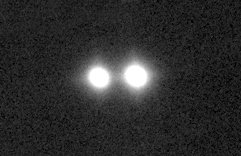Astronomy:HD 222259
| Observation data {{#ifeq:J2000.0|J2000.0 (ICRS)|Epoch J2000.0 Equinox J2000.0 (ICRS)| [[History:Epoch|Epoch J2000.0]] [[Astronomy:Equinox (celestial coordinates)|Equinox J2000.0}} | |
|---|---|
| Constellation | Tucana |
| HD 222259A | |
| Right ascension | 23h 39m 39.48096s[1] |
| Declination | −69° 11′ 44.7093″[1] |
| Apparent magnitude (V) | 8.47[2] |
| HD 222259B | |
| Right ascension | 23h 39m 39.26995s[1] |
| Declination | –69° 11′ 39.4950″[1] |
| Apparent magnitude (V) | 9.84[3] |
| Characteristics | |
| Spectral type | G6V+K3V[3] |
| Astrometry | |
| Radial velocity (Rv) | 8.30±0.2[4] km/s |
| Proper motion (μ) | RA: 79.30[5] mas/yr Dec.: -67.62[5] mas/yr |
| Parallax (π) | 21.89[5] ± 0.84 mas |
| Distance | 149 ly |
| Details | |
| HD 222259 A | |
| Mass | 1.01±0.06[6] M☉ |
| Radius | 0.964±0.029[6] R☉ |
| Luminosity | 0.725±0.013[6] L☉ |
| Temperature | 5428±80[6] K |
| Age | 45±4[6] Myr |
| HD 222259 B | |
| Mass | 0.84±0.06[6] M☉ |
| Radius | 0.864±0.036[6] R☉ |
| Luminosity | 0.327±0.010[6] L☉ |
| Temperature | 4700±90[6] K |
| Age | 45±4[6] Myr |
| Other designations | |
| Database references | |
| SIMBAD | AB |
HD 222259 (DS Tucanae) is a binary star system in the constellation of Tucana. It has an apparent visual magnitude of 8.5,[6] and is a RS Canum Venaticorum variable.[7] The system is notable for being young as a member of the 45 Myr old Tucana-Horologium moving group[8] and for the primary star hosting the confirmed exoplanet DS Tucanae Ab, discovered by TESS.[9][6][10][11]
Stellar System
HD 222259 is a visual binary.[3] The binary consists of a G6V primary and a K3V secondary separated by 5".[12] Based on radial velocity measurements it was suggested that the secondary itself is a binary, but later studies could not find evidence for this claim.[6]
Physical properties
High levels of magnetic activity, a strong 6708Å lithium line, and the position on the color-magnitude diagram, slightly above the main sequence, strongly support a young age of the system.[10]
Planetary System
| Companion (in order from star) |
Mass | Semimajor axis (AU) |
Orbital period (days) |
Eccentricity | Inclination | Radius |
|---|---|---|---|---|---|---|
| b | <1.3 MJ | 0.18+0.13 −0.12 |
8.138268 | — | 89.5+0.34 −0.41° |
5.70±0.17 R⊕ |
DS Tuc Ab is one of the few transiting planets with an age smaller than 100 Myrs. Other examples are K2-33b, V1298 Tauri b and AU Microscopium b. Of these systems DS Tuc is the brightest and it is a good target for atmospheric characterization with JWST. The planet is a super-Neptune or sub-Saturn.[6] The planet might be an inflated planet with an upper mass limit of 20 M⊕.[10] DS Tuc Ab will be observed by ESA's CHEOPS mission to characterize the planet.[13]
References
- ↑ 1.0 1.1 1.2 1.3 Gaia Collaboration (2018-08-01). "Gaia Data Release 2 - Summary of the contents and survey properties" (in en). Astronomy & Astrophysics 616: A1. doi:10.1051/0004-6361/201833051. ISSN 0004-6361.
- ↑ Høg, E.; Fabricius, C.; Makarov, V. V.; Urban, S.; Corbin, T.; Wycoff, G.; Bastian, U.; Schwekendiek, P. et al. (March 2000). "The Tycho-2 catalogue of the 2.5 million brightest stars" (in en). Astronomy and Astrophysics 355: L27–L30. ISSN 0004-6361. Bibcode: 2000A&A...355L..27H.
- ↑ 3.0 3.1 3.2 Torres, G. (August 1988). "Visual Measurements of Southern Double Stars - Part Three" (in en). Astrophysics and Space Science 147 (2): 257–266. doi:10.1007/BF00645670. ISSN 0004-640X. Bibcode: 1988Ap&SS.147..257T.
- ↑ Gontcharov, G. A. (November 2006). "Pulkovo Compilation of Radial Velocities for 35 495 Hipparcos stars in a common system" (in en). Astronomy Letters 32 (11): 759–771. doi:10.1134/S1063773706110065. ISSN 1063-7737. Bibcode: 2006AstL...32..759G.
- ↑ 5.0 5.1 5.2 Leeuwen, F. van (2007-11-01). "Validation of the new Hipparcos reduction" (in en). Astronomy & Astrophysics 474 (2): 653–664. doi:10.1051/0004-6361:20078357. ISSN 0004-6361. Bibcode: 2007A&A...474..653V.
- ↑ 6.00 6.01 6.02 6.03 6.04 6.05 6.06 6.07 6.08 6.09 6.10 6.11 6.12 6.13 6.14 Newton, Elisabeth R.; Mann, Andrew W.; Tofflemire, Benjamin M.; Pearce, Logan; Rizzuto, Aaron C.; Vanderburg, Andrew; Martinez, Raquel A.; Wang, Jason J. et al. (July 2019). "TESS Hunt for Young and Maturing Exoplanets (THYME): A Planet in the 45 Myr Tucana-Horologium Association" (in en). The Astrophysical Journal Letters 880 (1): L17. doi:10.3847/2041-8213/ab2988. ISSN 0004-637X. Bibcode: 2019ApJ...880L..17N. http://eprints.keele.ac.uk/6665/1/Newton_2019_ApJL_880_L17.pdf.
- ↑ Samus', N. N.; Goranskii, V. P.; Durlevich, O. V.; Zharova, A. V.; Kazarovets, E. V.; Kireeva, N. N.; Pastukhova, E. N.; Williams, D. B. et al. (July 2003). "An Electronic Version of the Second Volume of the General Catalogue of Variable Stars with Improved Coordinates" (in en). Astronomy Letters 29 (7): 468–479. doi:10.1134/1.1589864. ISSN 1063-7737. Bibcode: 2003AstL...29..468S.
- ↑ Zuckerman, B.; Webb, R. A. (2000-06-01). "Identification of a Nearby Stellar Association in theHipparcos Catalog: Implications for Recent, Local Star Formation" (in en). The Astrophysical Journal 535 (2): 959. doi:10.1086/308897. ISSN 0004-637X. Bibcode: 2000ApJ...535..959Z.
- ↑ Albright, Charlotte. "Dartmouth Astronomer on Leading Discovery of a New Planet | Dartmouth News". https://news.dartmouth.edu/news/2019/08/dartmouth-astronomer-leading-discovery-new-planet.
- ↑ 10.0 10.1 10.2 10.3 Benatti, S.; Nardiello, D.; Malavolta, L.; Desidera, S.; Borsato, L.; Nascimbeni, V.; Damasso, M.; D'Orazi, V. et al. (October 2019). "A possibly inflated planet around the bright young star DS Tucanae A" (in en). Astronomy & Astrophysics 630: A81. doi:10.1051/0004-6361/201935598. ISSN 0004-6361. Bibcode: 2019A&A...630A..81B.
- ↑ "DS Tuc A b". https://exoplanetarchive.ipac.caltech.edu/cgi-bin/DisplayOverview/nph-DisplayOverview?objname=DS+Tuc+A+b&type=CONFIRMED_PLANET.
- ↑ Torres, C. a. O.; Quast, G. R.; Silva, L. da; Reza, R. de la; Melo, C. H. F.; Sterzik, M. (2006-12-01). "Search for associations containing young stars (SACY) - I. Sample and searching method" (in en). Astronomy & Astrophysics 460 (3): 695–708. doi:10.1051/0004-6361:20065602. ISSN 0004-6361. Bibcode: 2006A&A...460..695T.
- ↑ "AO-1 Programmes - CHEOPS Guest Observers Programme - Cosmos". https://www.cosmos.esa.int/web/cheops-guest-observers-programme/ao-1-programmes.


